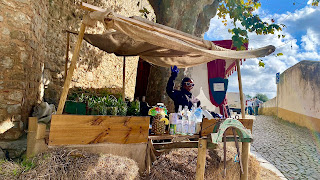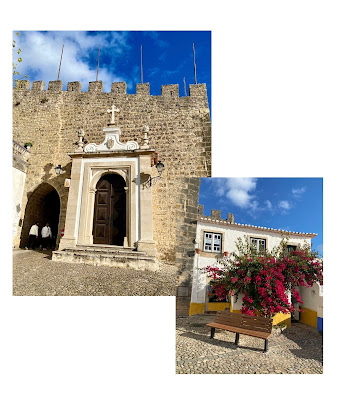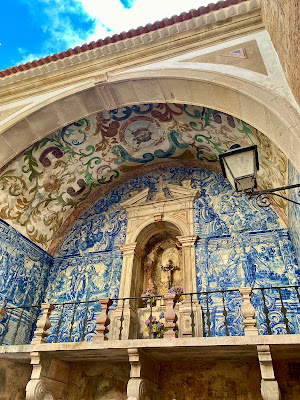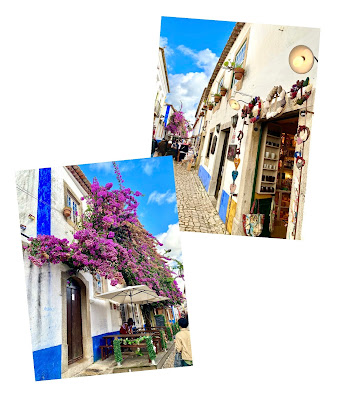Traveling broadens your horizon. It enriches your mind and your spirit. But traveling uses up a lot of your time and treasure. It would be a waste if you missed something on your trip you should’ve seen or experienced. It happened to me several times and I regretted that so much. If you’re planning a trip, I’d like to help you avoid missing out. So, let my blog show you what to look out for. Prepare for your trip by traveling with me through this post. Or you might still be in the praying and dreaming stage. Manifesting your dream into reality starts here!
A Happy Solo in Óbidos, PortugalCan anything evoke
imaginings of medieval days more than a village favored by queens? A walled
town with a towering castle. Winding streets bursting with colors.
Picturesque little
shops tempting you to sample their wares.
Radiant blooms
and quaint curios adding
rustic beauty to its cobbled lanes.
Such is Óbidos, the Vila
das Rainhas (Town of the Queens), A UNESCO Creative City and voted as one
of the Seven Wonders of Portugal. This walled town is one of the best-preserved
in Europe and the finest model of a traditional Portuguese village. It dates
back to the Celtic period. What adds to its appeal is its authenticity. Around a
hundred inhabitants still practice their craft and live in the pretty, blue or
yellow-bordered, white-washed houses within the walled district and 3,000 in
the town proper.
From the Celts to the
Romans, to the Visigoths, to the Moors, Óbidos was
finally conquered by the Portuguese in the 12th century. In 1282, the
soon-to-be queen Isabel de Aragon expressed admiration for its beauty. Because
of that, King Dinis gifted her with Óbidos for their wedding. Since then, it
has been the exclusive property of the Queens of Portugal until 1883.
Let’s discover what the
queens found enchanting here and what you should look out for when it’s your
time to visit the town their majesties have graced.
Stepping off the bus, I
already felt the old-world magic of Óbidos beguiling me.
After a short walk, we reached
the ancient walls that encircle the whole town and entered through Porta
da Vila, the main town gate.
Keep your eyes peeled
as you enter the gate. Just inside it is a balcony decorated with the iconic azulejos.
The blue and white tiles from 1740 depicts the Passion of Christ. Its
painted ceiling features a crown of thorns. This niche between the outer and
inner walls serves as an oratory, a small chapel.
You can walk over the
13-meter high battlements encircling the town for panoramic views if you’re
adventurous enough or have the time or don't have vertigo. The steps are immediately to the left of
Porta da Vila. As for us, we headed straight to Rua Direita, the main
and only real street of the town.
The main street is lined with
postcard-pretty flowers, galleries, shops and cafés.
This tops my list of
the best shopping streets that I have ever strolled through in all my travels.
Not because it offered bargains and must-have items but because it exuded charm
with a capital C. I actually didn’t even go on a buying spree and just purchased
one special item, but I had a wonderful time soaking up the ambiance.
I suggest taking a
leisurely walk up Rua Direita. Try to notice the arty-crafty things that you'll
encounter along the way.
Turning from the busy
main street into a quiet alley led us to the tree-covered Praça de Santa
Maria (Saint Mary Square) where the town’s main church is located.
For pilgrims and plain
tourists alike, the Igreja de Santa Maria (Church of Saint Mary)
is a must-visit because
of its interior: it’s azulejos-lined walls and painted ceiling dating
from the late 1600s,
the fine Baroque retábulo,
valuable paintings
especially the one on the right side-altar depicting the “Martyrdom and Life of St. Catherine of Alexandria" by the renowned artist Josefa de Óbidos.
And don’t miss the
nobleman’s tomb on the left side of the altar which is a masterpiece from the
Portuguese Renaissance period dated 1525. It was completely carved from stone
and is protected as a National Monument.
Uphill (don’t worry, it’s not a steep climb) is another church, the Igreja de São Tiago (Church of St. James) which is now a bookstore, the Livraria de Santiago.
It’s sad that it’s no longer used as a church. In our last pilgrimage, our
leader made the comment that fewer people are going to European churches to
attend mass. Many just come as tourists. Or maybe Óbidos just had too many
churches for its small population. There are two other churches and a chapel we
didn’t have time to see.
Crowning our tour, atop
the hill, is Castelo de Óbidos. This
castle has been used as a military fortification since the Roman occupation. It
also functioned as a royal palace and is one of Portugal’s
greatest medieval castles. The main building where the king’s room was located
now houses a pousada (in
Portugal, a luxury hotel in a restored historic building). I wish we could’ve
spent the night there. Or would that be too scary with ghostly royals keeping
you company?
One of the things that
you absolutely must try is the Ginja de Óbidos or ginjinha, a
cherry liqueur served in chocolate cups. It was concocted by 17th century
monks who steeped Morello cherries in brandy.
It’s sold in many stores in Rua Direita and costs 1 Euro for a shot.
Chocolate and cherry! I
didn’t let that experience pass me by – drinking the delicious liqueur then eating
the cup. That was my one special purchase I previously mentioned. My roommate
Leni and I each bought a set of 10 cups with a small bottle so our families can
enjoy it for the Christmas holidays. (Best refrigerated till you’re ready to
drink it.)
Last suggestion: after
you exit the town gate, go across the street from the Tourist Center to view the Aqueduto de Óbidos.
This aqueduct streamed drinking water from a spring in Usseira over 3 kms. of
vineyards and orchards to the town’s fountains. It’s not as impressive as the
one we would later see in Segovia but it’s picture-pretty enough.
Óbidos not only charmed me but also stirred my artistic passion. It was sparked by a sight I beheld as we meandered along Rua Direita – a single white calla lily holding court like a queen amidst a foliage of green framed by a saffron yellow wall that just captivated me.
I painted that snapshot in watercolor and named it “Rainha Lírio de Óbidos” (Queen Lily of Óbidos). It’s the
best souvenir I can ever have of “The Wedding Present Town” (another name by
which Óbidos is known).
Óbidos was not in my
bucket list but I’m so blessed the Lord brought me here. God’s bucket list for
me is way better than my own.



























No comments:
Post a Comment